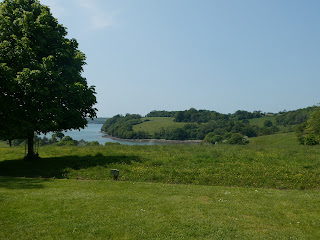Nu hebben we
in de twaalf dagen dat we op deze camping staan een aantal keren ’s avonds laat
honden horen blaffen. Ergens op een boerderij vermoeden wij, maar zeker niet
van onze boer. Meestal rond een uur of elf. Dat stopte dan wel weer na een half
uur.
Onze
buurvrouw was het ook opgevallen. Zij is een frequente gast en vertelde dat ze
die honden voor het eerst hoort.
Vannacht
begon de heibel om twee uur en het blaffen ging uren door.
Iedereen
(nou ja, zes units) had het er vanmorgen over. De buurvrouw sms’te de boer –
maar naar later bleek had die al een berichtje van een andere camper ontvangen
om half vier.
Hij kwam zijn
excuses aanbieden en zou uit gaan zoeken welke boer zijn honden niet onder
controle houdt.
Een andere
invalshoek, van twee Duitse dames, vond ik wel geloofwaardig. Volgens hen liep
er ergens een vos. Het zou dus zomaar kunnen dat de honden ’s nachts losgelaten
worden om de vos de stuipen op het lijf te jagen.
Maar dat
gaat ten koste van de (nacht)rust op deze camping, en de boer wil graag 100%
tevreden gasten. Tot nu toe teert hij op top reviews.
Wordt
vervolg!
Op deze,
wederom zonovergoten, maandag besloten we opnieuw naar het schiereiland
Roseland af te dalen.
Het huis ligt op een bijzondere plek, maar is qua interieur niet erg interessant.
Het moet een gigantische operatie zijn geweest waar een bescheiden monument ons aan doet herinneren. Iedereen weet van D-Day en de invasie op de Normandische kusten. Maar aan waar het startpunt lag wordt weinig aandacht besteed.
Turn left just before the road to the King Harry Ferry, near St
Just-in-Roseland, and you come to a whole area of the Roseland which was
restricted in 1944, the remnants of which can still be seen almost 80 years on.
In a field to your right stands a concrete building which was the barrier
manned by military police. Turn right just after it and you'll find yourself
driving down Yankee Road, as it was known.
The hasilty assembled, reinforced road
taking tanks, jeeps and lorries to the river to embark for Normandy is still
there and a stark reminder that this beautiful corner of Cornwall. This was
the last tranquil land many of the soldiers would ever see before arriving on
hellish Omaha Beach on June 6, 1944.
A bit further on and you get to the beach, with its view across the Fal
river to Trelissick House. It's now a haven for dog walkers and the odd boat,
moored off shore. However, the evidence of its important wartime role is still
there. Concrete plinths and the rusting remains of steel girders from the two
'Dolphin' embarkation jetties dot the beach.
It's hard to equate this
tucked-away beach and its still waters with the busy American outpost, which
would have seen hundreds of troops boarding ships alongside jeeps, tanks,
lorries and all manner of ammunition and equipment on a road which was built by
a mixture of Cornish workers and Irish navies. Yankee Road was covered in
asphalt by a company called Harbour and General of London to ensure it didn't
shine in the moonlight and attract the attention of German planes.
The Roseland Peninsula was a
critical training ground and embarkation site for the D-Day landings.
Throughout 1943 and the first half of 1944 an incredible 27,000 Americans
arrived in the Fal Estuary in preparation for the Normandy landings.
Daar genoten we van een overheerlijke cream tea. Dat is nog eens wat anders dan een glas heet water met een theezakje.




































































Geen opmerkingen:
Een reactie posten